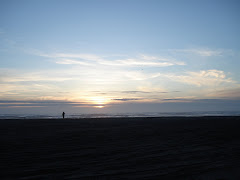By Brian Vastag
Posted July 24, 2008
US News and World Report Tuesday, August 12, 2008
Posted July 24, 2008
US News and World Report Tuesday, August 12, 2008
翻譯:Me; Sep. 16/2008
On an arid outcropping of basalt in northwestern Australia, some of the oldest rocks on Earth lie exposed to the fierce sun. Formed at the bottom of an ancient ocean, this volcanic material shelters what one scientist calls the "oldest robust evidence" of life. At a scientific meeting at Rockefeller University in May, Roger Buick of the University of Washington said that the 3.5 billion-year-old rocks hold traces of carbon that once made up living organisms.
澳洲西北部,一脈玄武岩礦裸露在嚴厲的日晒下;這是地球上最老的岩石之一。它是遠古時海底火山爆發所形成的。一位科學家說它覆蓋著生命最古老及可靠的證據。今年五月在洛克菲洛大學 (Rockefeller University) 舉行的科學會議裡,華勝頓大學 (University of Washington) 的 Roger Buick 說,那片35 億年老的岩石中所含微量的碳曾是遠古生物的一部份。
Even before Buick's discovery, ample evidence indicated that life on Earth began while our 4.5 billion-year-old planet was very young. Simple organisms certainly flourished between 2 billion and 3 billion years ago, and claims of older evidence of life have periodically surfaced. But none have been universally embraced, and Buick's claim is so new that other scientists haven't fully reviewed it.
甚至在 Buick 發現這一點以前,就有充份的證據顯示生命起源時,地球還很年輕。地球如今年屆 45 億年。科學家肯定,二,三十億年前簡單的生命已經很興旺。不時還有人宣稱有更老的證據,但沒有一個被普遍的接受。Buick 的論點仍然太新,科學界尚未對它有詳細的評論。
Yet even if the geologist is right about his rocks, his discovery would leave unanswered one of life's biggest mysteries: how life actually arose. While creationists attribute that spark of life to the hand of God, scientists are convinced there's a natural explanation. Yet as close as they've come to pinning it down, some admit the particulars may never be fully resolved. Others are convinced that we're edging closer to an answer and to settling one of the oldest and most contentious questions in science and religion.
就算地質學家肯定了這片岩脈,Buick 的發現仍然無法解釋生命最大的謎題:生命到底是如何開始的。創造論者 (Creationists) 把它歸因於上帝之手點燃了生命的火花;科學界卻認定必有大自然的解釋。雖然眼見謎底就要揭曉了,有些科學家承認,其中細節可能永遠無法解決。另些些科學家則確信,一滴一點的,宗教與科學之間最古老的,最激烈的爭論,就快有結論了。
To solve the riddle of genesis, biologists, astronomers, geologists, and chemists are attacking the problem from all angles even trying to re-create life from scratch. In recent years, institutions, including Harvard University, the Georgia Institute of Technology, and McMaster University in Canada, have formed "origins" institutes to probe the deepest history of life on Earth and to search for life in the heavens. "The field is going through a mini renaissance," says chemical biologist Gerald Joyce of the Scripps Research Institute in La Jolla, Calif.
地球上的生命是如何開始的呢?生物學家,天文學家,地質學家,和化學家各從不同的角度在探討;有些甚至嘗試要用無生命的物質去創出生命來。近年來許多研究機構, 包括哈佛大學 (Harvard University),喬治亞理工學院 (Georgia Institute of Technology),和加拿大的 McMaster 大學,都已成立研究 “物種起源”的研究所來探討生命最原始的歷史並搜尋地球外的生命。位於加州 La Jolla 的 “Scripps 研究所 “ 的化學生物學家 Gerald Joyce 說:「這一行,目前正經歷著一個小型的文藝復興。」
According to scientists, life began when chemistry begat biology that is, when simple molecules assembled into more complex molecules that then began to self-replicate. But rocks that might harbor traces of such genesis events simply don't exist, says Buick. During Earth's opening act, space debris and cataclysmic volcanic upheavals destroyed the evidence, like an arsonist torching his tracks. The oldest known rocks are about 4 billion years old, yet even they formed roughly half a million millenniums after our planet's surface cooled and water first pooled into shallow seas. Scientists widely suspect that life began during that long, undocumented interval.
Theories about where and how life began range from the sublime to the bizarre. One camp says that deep-sea vents known as black smokers nurtured the first life. In the late 1970s, a team of researchers from Oregon State University unexpectedly discovered whole ecosystems thriving around a hot vent on the Pacific seafloor. Such vents, where molten rock from inside the Earth's mantle heats seawater to as much as 660 degrees Fahrenheit, could have provided the energy and basic organic molecules needed to spark life.
以科學的眼光看來,當化學反應導至生物行為時﹣也就是簡單的分子聚在一起形成複雜的分子並開始自我複製之時﹣也就是生命起源之時。 Buick 說 ,可惜,可能帶有創始生命蛛絲螞跡的岩石硬是不存在。地球早期,劇烈的火山爆發和隕石的撞擊,有如縱火者放火滅跡一樣,把所有的證據都已摧毀殆盡。我們所知最古老的岩石約是 40 億年老。在這之前約五億年,地球表面已經冷化,地表的水也已聚成淺海。科學界普遍相信,生命的形成正是在這段缺乏記錄的時期。
關於生命起源的理論形形種種,有些卓越超群,有些光怪離奇。有一派說,深海裡,俗稱黑煙囪的開孔養育出了第一個生命。1970 年代後期,奧勒岡州立大學 (Oregon State University) 的一組研究人員意外的在太平洋底一個高溫的開孔發現了幾個完整而生氣勃勃的生態系統。開孔附近,地殼下的熔岩把海水加熱到幾近華氏 660 度 (譯者註:約攝氏 350 度);由此提供了點燃生命所需的有機分子和能量。
Another camp believes that ice, not boiling water, served as the cradle of life. Even the coldest ice contains seams of liquid. These watery pockets could have acted as test tubes for the earliest organic reactions. Experiments show that units of RNA, the genetic material that was probably the forerunner to better-known DNA, spontaneously string themselves together in ice, supporting this theory.
另一派認為冰,而不是滾水,才是生命的搖籃。即使是最冷的冰也含有薄層的液態水。他們猜測最初的有機反應可能是發生在這些薄層的水中。支持這派理論的證據:實驗顯示 RNA 的確在冰中自然的結和在一起;RNA 這種遺傳物質可能是DNA的前身。
Still other scientists point to the skies. They argue that meteorites carrying amino acids and other important molecules seeded Earth with the necessary ingredient for life. Supporting the idea: high concentrations of amino acids inside meteorites found on Earth and in gas clouds in space. A wilder offshoot of this theory, called panspermia, suggests that whole bacteria life itself first evolved on Mars and then hitched a ride to Earth via small pieces of the Red Planet blasted here by asteroid or comet impacts. But no life has been found on Mars, and the one claim of fossil bacteria in a Martian meteorite, made by NASA scientists in 1996, has been almost universally rejected.
還有其他科學家則把箭頭指向天空。含有胺基酸及其他重要分子的隕石把生命所需的成份下種在地球上。 支持這種觀念的證據:落在地球上的隕石及太空中的氣雲都含有高濃度的胺基酸。 Panspermia 是這派之想像力特別豐富的,他們的意見:細菌根本是發源於火星;小行星或大隕石的撞擊把火星的碎片帶到了地球。但是火星上尚未發現有生命。1996 年,美國國家太空總署 (NASA) 科學家聲稱在火星上的隕石發現細菌的化石;當今科學界普遍的不接授這個證據。
Perhaps the leading theory focuses on a much more prosaic realm: the slimy interface where the sea laps against land. If early oceans carried organic molecules and they most likely did the porous surfaces of shoreline minerals could have helped organize such building blocks into primitive structures. Eventually, these units could have replicated, forming thin films on the seashore rocks, says Robert Hazen, a researcher at the Carnegie Institution in Washington.
目前站上風的理論把注意力集中在比較平凡的地方:海水舔舐路地的那片泥濘。如果早期的海洋含帶有機分子,這個可能性很大,那麼海岸邊多孔的礦物質很可能促成那些建材形成原始的結構。到後來這些結構終於自我複製,並薄薄的覆蓋著岸上的岩石。這是 Robert Hazen 的意見;他在卡內基研究所 ( Carnegie Institution in Washington )做研究。
Scientists favoring one or another theory have tried to boost their case by attempting to re-create the elements of life—and even life itself—from the bottom up. Such work sparked to life in 1953, when two researchers cooked up a "primordial soup" of amino acids. In their University of Chicago lab, they applied simulated lightning to a pair of flasks that contained, respectively, an oceanlike solution and an atmosphere rich in methane, water vapor, ammonia, and hydrogen. That experiment and subsequent ones showed that simple chemistry can transform nonorganic molecules into the building blocks of life.
地球上的生命是如何開始的呢?科學界有各式各樣的理論。科學家們各有偏好;為了替自己的理論提供更有力的證據,有些人嘗試從底層做起,從新創造生命的成份﹣甚至生命本身。這些嘗試在 1953 年暴出了火花:芝加哥大學 (University of Chicago) 的兩位研究人員把各種胺基酸摻在一起煮成 「原始湯」放入兩個 燒瓶;瓶中含有海水般的溶液並充滿了甲烷,水蒸氣,氨,和氫氣。然後用人造閃電去打擊它。這個實驗和往後追加的更多的實驗證明了簡單的化學反應就能把無機的分子轉變為生命的基本建材。
"The classic experiments done over a period of 50 years give us confidence that the building blocks would have been present," says Andrew Knoll, a paleontologist at Harvard University. "The big question is how do you go from there to something that can replicate itself." A pile of lumber, after all, is not a house.
哈佛大學古生物學家 Andrew Knoll 說:「過去 50 年來許多傑出的實驗確認了當初的確存在有生命的基本建材。問題在那些建材如何開始能自我複製。」必竟一堆木材離一棟房子還有一大段距離。
To understand how the transition might have occurred, a handful of scientists are striving to re-enact it in the lab. Jack Szostak of Harvard Medical School is at the forefront of this work. In his lab, researchers fill test tubes with the barest ingredients of life, then watch the elements self-assemble into what look like primitive cells, hoping that they will begin replicating. "Sooner or later, life will be made in the lab," says Joyce, who performs similar experiments.
這個轉變是如何開始的呢?有那些可能性呢?一小撮科學家正在實驗室中努力的嘗試重演這個轉變的過程。 哈佛大學醫學院的 Jack Szostak 是其中先驅。在他的實驗室裡,研究人員把生命所必需,最原始的素材放進試管中,然後看著它們自己裝配成看來像是原始細胞的東西;並期待它們能自我複製。Joyce 是另一位做類似研究的科學家。他說:「遲早人類會有能力在實驗室中造出生命來。」
While none of these primitive cells have yet "gone critical" and started to copy themselves, the research has already paid real-world dividends, including one blockbuster pharmaceutical and perhaps more to come. The drug Macugen treats macular degeneration, the leading cause of blindness in the elderly, with a tiny snippet of the genetic molecule RNA. Since scientists like Szostak think RNA preceded DNA, they've invented ways of pushing RNA to evolve in test tubes.
雖然還無人能使這些原始細胞的雛形突破瓶頸而自我複製,但是這類的研究已經有了實質上的收獲﹣一個無比成功的新藥因之而產生,還有更多的新藥會接踵而來。 Macugen 這個藥利用一小段遺傳 RNA 來治療 macular degeneration,這種萎縮是造成老年人瞎眼主要的原因。 Szostak 及同行的科學家相信 RNA 是 DNA 的前軀,他們發明了各種辦法來迫使 或誘導RNA 在試管中演化。
Under the right conditions, that process can produce an RNA molecule that's evolutionarily "fit" for a task like treating the biological cause of macular degeneration.
Hazen says that origins-of-life experiments may also help create synthetic cells that can churn out biofuels, which would be a boon in these days of energy crunches and concerns about climate change. "Life takes things like carbon dioxide and water and makes useful compounds, including fuels," he says. "If we understand in a basic way how that's done," he adds, then scientists might be able to build a primitive, fuel-producing protocell.”
在恰當的情況下,如此的程序能造出一種 RNA分子;這種分子能演化而用來治療 macular degeneration 生物學上的病因。 Hazen 說,從事探討生命起源的各種實驗可能還會幫助我們人工合成各種細胞;從而源源不絕的造出種種的生物燃料 (biofuels),這對當前的能源短缺和氣候改變將大有助益。 他說:「生命利用二氧化碳和水等東西製造各種複合物,燃料是其中一例。」他接著又加一句:「如果我們瞭解這種程序基本上是怎麼進行的,科學家也許就可以製造出某種原始的光細胞來製造燃料。」
Such a self-replicating system, Joyce and Szostak contend, would constitute life. And while such a feat may not exactly recapitulate how biology began, it would be example No. 2—the first being the entire panoply of plants, animals, and other organisms that now dominate our planet.
Joyce 和 Szostak 極力主張,如此的自我複製的系統就可以說是生命了。就算當初生物不見得是這樣源起的,這樣的技術也應該算是生命起源的第二個例子吧。所謂的第一個例子指的是當今遍蓋著我們這個星球的所有動植物以及所有其他的生物。











No comments:
Post a Comment